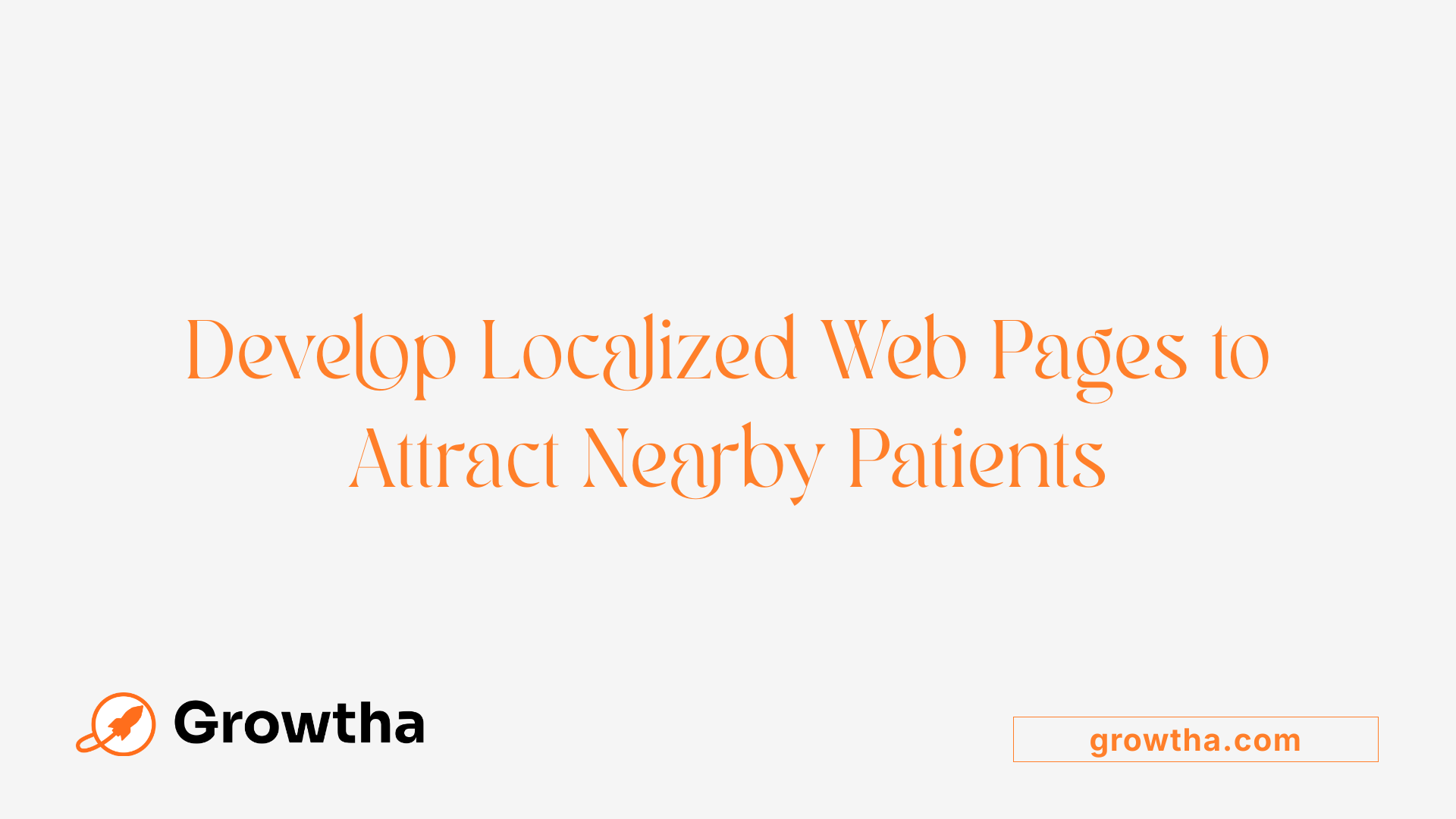Best Practices for Local SEO During Healthcare Mergers
Navigating the Challenges of Local SEO in Healthcare Mergers and Acquisitions


Best Practices for Local SEO During Healthcare Mergers
Understanding the Critical Nature of Local SEO During Healthcare Mergers
Healthcare mergers and acquisitions present unique challenges and opportunities for digital visibility. As organizations rebrand, expand, or consolidate, maintaining a strong local SEO presence becomes vital for attracting nearby patients and ensuring continued growth. This article explores best practices, strategic approaches, and real-world examples for managing local SEO effectively during these transformative periods.
Comprehensive Content Updates Reflecting Organizational Changes
 When your healthcare organization undergoes rebranding or structural changes, maintaining a consistent and optimized online presence is vital to preserving visibility and patient trust. This involves comprehensive updates across all digital assets to reflect the new organizational identity.
When your healthcare organization undergoes rebranding or structural changes, maintaining a consistent and optimized online presence is vital to preserving visibility and patient trust. This involves comprehensive updates across all digital assets to reflect the new organizational identity.
Start by revising your website content to incorporate your new branding elements, such as logos, slogans, and organizational messaging. Ensure that all service descriptions, staff bios, and practice descriptions are aligned with the latest organizational developments.
Each location should have a updated, location-specific page that accurately captures the new branding and services. These pages should include NAP details, local keywords, and schema markup tailored to each site, enhancing local search relevancy.
Managing your Google Business Profiles (GBP) is crucial. Update each profile with the latest practice name, address, phone number, hours, categories, and high-quality images that showcase the rebranded identity. Regularly post updates about organizational changes, new services, or community involvement through GBP posts.
Online reputation management also plays a role. Encourage satisfied patients to leave reviews reflecting their experience with the new organization, and respond professionally to feedback to reinforce trust.
Technical SEO fundamentals must not be neglected. Verify that your website remains mobile-friendly, loads quickly, and has a clear, logical architecture. Implement or update schema markup to include current organizational details and service information.
Finally, produce high-quality patient-centric content. Blogs and FAQs addressing organizational updates, new services, and patient concerns help reassure your audience and strengthen SEO. Consistently monitor your SEO performance through analytics tools to adapt your strategy as necessary.
In summary, effective healthcare SEO during organizational changes combines content updates, profile management, technical SEO, and reputation building—all aimed at ensuring a smooth transition that sustains visibility and patient engagement in your community.
Optimizing Google My Business and Local Listings During Mergers

How can healthcare organizations maintain or improve local search visibility during mergers?
During mergers, healthcare organizations face the challenge of preserving or boosting their visibility in local search results. One of the most effective strategies is to thoroughly optimize and regularly update Google My Business (GMB) profiles for each location involved in the merger. This includes claiming and verifying each listing, ensuring that all NAP (Name, Address, Phone number) details are correct and consistent across all online platforms.
Creating dedicated, location-specific landing pages on the website helps demonstrate relevance in local searches. These pages should contain unique content, relevant local keywords, and accurate contact information. Incorporating specific details about each practice location boosts search engine rankings and makes it easier for patients to find accurate information.
Encouraging satisfied patients to leave positive reviews on Google, Facebook, Yelp, and medical review sites is crucial. Actively managing and responding to these reviews builds trust, improves reputation, and signals activity to search engines, which positively influences rankings.
In addition, optimizing the healthcare website for mobile friendliness, quick load times, and straightforward navigation improves user experience and boosts local SEO efforts. Building local citations—mentions of NAP information on regional directories, industry sites, and local media—further solidifies the practice’s online presence.
Ultimately, consistent NAP information, engaging content, and active reputation management are central to maintaining and enhancing local visibility during organizational changes like mergers, attracting and retaining new patients in each location.
Creating and Optimizing Location-Specific Web Pages

How can healthcare providers develop detailed, localized content for each location?
Creating comprehensive, localized pages involves crafting at least 500 words per location that highlight specific amenities, services, and community involvement. Incorporate local landmarks, neighborhood details, and relevant keywords naturally into the content. This helps search engines associate the page with the specific area and improves visibility in local searches.
How should local keywords, landmarks, and neighborhood information be integrated?
Embed neighborhood names, local terminologies, and nearby landmarks within the content, headings, and meta descriptions. Use location-based keywords like "chiropractic care in Downtown Miami" or "pediatric dentist near Riverside Park" to target specific searches.
What role do schema markup and location-specific URLs play?
Implement schema markup to provide search engines with detailed information about each location, including address, hours, and services. Use unique URLs for each location, such as www.yourpractice.com/miami or /riverside-dental, ensuring they are clear, descriptive, and keyword-rich to boost local relevance.
How can provider bios and staff information build trust?
Including detailed bios, staff qualifications, and photos humanizes your practice, fostering trust with prospective patients. Highlight local staff members and their community involvement to create a personal connection.
| Strategy | Benefit | Details |
|---|---|---|
| Localized Content | Improves search ranking | Focus on community-specific keywords and info |
| Schema Markup | Rich snippets | Better understanding of your practice by search engines |
| Location URLs | Clarity and relevance | Descriptive, keyword-rich URLs for each site |
| Staff Bios | Trust and credibility | Personalize your practice and showcase expertise |
How do these strategies enhance visibility during healthcare transitions?
During mergers or relocations, clear, detailed, and localized web pages ensure that patients and search engines find accurate information easily. Regular updates and consistent NAP details across all pages maintain your online presence’s integrity, helping your practice stay prominent in local markets.
What are best practices for continuous optimization?
Regularly review and update content with new services, community news, and patient testimonials. Create location-specific blog articles, engage with local media, and monitor your SEO metrics to adapt strategies effectively. Keeping content fresh and relevant guarantees sustained visibility and trust in your community.
Managing Online Reputation and Patient Reviews During Mergers

How should healthcare providers manage online reputation, reviews, and Google Business Profiles during mergers?
Healthcare mergers present unique challenges and opportunities in managing online reputation. To ensure a smooth transition, providers must actively monitor and respond to patient reviews across various platforms, including Google, Facebook, Yelp, and healthcare-specific sites. Engaging with reviews promptly—whether they are positive affirmations or negative feedback—demonstrates a commitment to patient satisfaction and builds trust.
Updating all digital profiles is essential. This includes ensuring that Google Business Profiles (GBPs) and other directory listings display current and accurate information that clearly reflects the new organization structure. Consistency in NAP (name, address, phone number) and branding across all platforms reinforces credibility and helps improve local SEO rankings.
Leveraging reputation management tools can greatly enhance this process. Platforms designed for healthcare, such as reputation monitoring software, enable staff to analyze sentiment, track reviews, and gather insights into patient feedback at individual locations. This data supports strategic decisions to improve services and address any recurring issues.
Encouraging satisfied patients to share positive reviews is another vital aspect. This can be achieved through follow-up emails, in-office prompts, and social media campaigns that request reviews in a respectful and HIPAA-compliant manner.
Responding professionally to negative reviews is equally important. Transparent, empathetic, and prompt responses demonstrate accountability and a dedication to resolving concerns. Sharing success stories and testimonials can further bolster the organization’s reputation.
Ultimately, maintaining an active online presence, addressing feedback openly, and utilizing specialized reputation management tools help protect the merged entity’s brand image, attract new patients, and foster long-term loyalty. Continuous engagement and transparent communication are crucial steps toward thriving in the post-merger healthcare landscape.
Tailoring Local SEO Tactics for Healthcare Mergers
 When healthcare organizations undergo mergers, adjusting local SEO strategies is crucial to maintain and enhance online visibility in their combined markets.
When healthcare organizations undergo mergers, adjusting local SEO strategies is crucial to maintain and enhance online visibility in their combined markets.
One essential approach is creating dedicated location pages or microsites for each practice location. These pages should have unique URLs and comprehensive local information that includes accurate NAP details, services offered, hours, and community-specific content. Tailoring these pages with location-specific keywords maximizes relevance in local searches.
Claiming and optimizing individual Google My Business (GMB) profiles for each site is equally important. Each profile should be fully completed with high-quality images, detailed descriptions, and accurate category selections. Regular updates, engaging with reviews, and responding to patient inquiries demonstrate activity and responsiveness, which search engines favor.
Building local backlinks through citations, partnerships, and media mentions improves authority and boost rankings. Consistently listing each location with the same NAP details across trusted directories such as Yelp, Healthgrades, and local health industry sites ensures consistency and trustworthiness.
Encouraging patient reviews at each location helps strengthen reputation and enhances local search visibility. Practices should implement strategies for collecting positive feedback across platforms like Google, Facebook, and healthcare review sites, and respond professionally to all reviews.
Using local keywords throughout content, including website meta tags, blog posts, and schema markup, increases relevance for nearby users. Incorporating location-specific terms like “near me,” city names, and regional keywords in titles and descriptions signals relevance to search engines.
Monitoring success through analytics — tracking traffic, review activity, and conversions such as calls and online appointments — allows practices to refine their strategies actively. In an era where mergers expand healthcare networks, such tailored local SEO tactics are vital for sustaining and growing patient bases.
Case Studies Demonstrating Successful Healthcare SEO During Mergers
Are there case studies or examples that illustrate effective healthcare SEO strategies during mergers?
Yes, there are several notable case studies that showcase how healthcare organizations can successfully implement SEO strategies during mergers.
One prominent example is Robb Digital’s seven-year partnership with a major healthcare organization. During this period, Robb Digital specialized in optimizing local SEO, content, and technical website elements. When the merger was underway, the organization experienced a dramatic increase in online visibility.
Within just six weeks, its search visibility improved tenfold. This surge was driven by targeted content optimization, thorough keyword research tailored to local and service-specific search terms, and technical enhancements like schema markup and mobile optimization. As a result, the healthcare provider's website ranked higher in search engine results, secured featured snippets, and saw a significant rise in organic traffic.
The focus on local SEO — including creating location-specific landing pages with consistent NAP data, rich media, and patient reviews — strengthened the organization’s online presence. Managing reputation by encouraging positive reviews and engaging with patient feedback also played a vital role.
Additional examples include community-focused campaigns such as the KC Wellness Center and Leawood Total Wellness Center. These organizations invested in paid search strategies alongside website redesigns and optimized landing pages. These efforts led to notable boosts in patient inquiries and engagement, especially via targeted local advertising.
Furthermore, innovative approaches like influencer collaborations at Monarch Plastic Surgery and AI-powered content creation at Turning Point Wellness exemplify multi-channel SEO and marketing tactics. These strategies enhanced lead generation during periods of organizational transition.
Such case studies illustrate that comprehensive, multi-faceted SEO efforts — combining local optimization, reputation management, content marketing, and paid advertising — are highly effective to support healthcare mergers. They help increase visibility in local searches, attract new patients, and facilitate smooth organizational integration.
| Case Study | Main Strategy | Results | Additional Notes |
|---|---|---|---|
| Robb Digital & Healthcare Org | Local SEO, Content Optimization, Technical SEO | 10x search visibility in 6 weeks | Focused on local landing pages and reviews |
| KC Wellness & Leawood Total Wellness | Paid Search, Website Redesign | Increased patient inquiries | Targeted local campaigns |
| Monarch Plastic Surgery | Influencer Collaborations | Improved leads & inquiries | Used social influencers |
| Turning Point Wellness | AI-Generated Content | Boosted patient engagement | Tech-driven approach |
Guidelines for Adapting SEO Strategies During Industry Consolidation
What guidelines should healthcare organizations follow to adapt their SEO strategies during industry consolidations?
During periods of industry consolidation, healthcare organizations must fine-tune their local SEO efforts to maintain and improve their online visibility. A foundational step is to meticulously update and ensure consistency of the Practice Name, Address, Phone Number, and Website (NAPW) information across all online platforms, directories, and listings. Inconsistent data can harm search rankings and diminish trust, making regular audits essential.
Creating localized, high-quality content tailored to the specific communities each location serves enhances relevance and engagement. Incorporate long-tail keywords that reflect both the location and specific healthcare services or specialties. Content such as blog articles, FAQs, and patient success stories should be optimized for local intent while following E-E-A-T principles—expertise, experience, authority, and trustworthiness—by involving qualified healthcare professionals.
Optimizing each Google Business Profile (GBP) is crucial. Fully complete every profile with accurate details, relevant categories, high-quality images, updated hours, and appointment links. Manage reviews diligently by encouraging satisfied patients to leave positive feedback and responding professionally to all reviews. Adding schema markup and posting regular updates improves search engine understanding and engagement.
Technical SEO elements also play a vital role. Ensure your website loads quickly, is mobile-friendly, uses HTTPS security, and maintains a clear, logical architecture. These factors enhance user experience and help search engines crawl your site effectively.
Monitoring performance is vital to adapt strategies successfully. Use tools like Google Analytics and Search Console to track organic traffic, conversions, and ranking data. Build relationships with local community sources, sponsorships, and healthcare-specific directories to earn valuable backlinks. Partnering with experienced healthcare SEO specialists can streamline this process, ensure compliance with regulations such as HIPAA, and help craft a resilient, adaptable SEO strategy.
In summary, healthcare practices should focus on accurate data management, localized content, profile optimization, technical excellence, and continuous performance analysis to thrive amidst industry changes and consolidations.
Performing Local Keyword Research and Content Localization in Mergers
When healthcare organizations merge or expand into new communities, customizing their local SEO strategies becomes critical for attracting nearby patients and standing out in local search results.
To start, providers should analyze the specific health needs, preferences, and search behaviors of the target community. Tools like KW Finder, Moz, and Google Trends are invaluable for uncovering popular local search terms, trending topics, and competitor keywords within the region.
Incorporating geographically relevant keywords such as the city name, neighborhoods, or common phrases like 'near me' into your content and metadata enhances visibility. For example, using keywords like "Pediatric Care in Downtown Chicago" or "Chiropractors Near Hyde Park" helps your practice show up when potential patients look for services in those areas.
Creating dedicated location pages is a best practice. Each page should include specific details: address, phone number, local keywords, healthcare services offered, images, and testimonials relevant to that community. Optimized Google My Business profiles for each location further improve local prominence.
Building local backlinks from reputable regional directories, community organizations, and news outlets adds authority and improves search rankings. Consistently updating content with health tips, local news, and seasonal offerings tailored to each community helps maintain relevance.
Furthermore, focusing on long-tail keywords, such as those in the Keyword Golden Ratio (KGR), targets less competitive but highly specific queries, increasing chances to rank higher and attract qualified leads.
Finally, ongoing monitoring through analytics tools is essential. Tracking search performance, analyzing keyword gaps, and adapting content based on seasonal trends and community needs ensure sustained success in driving local traffic after a merger or expansion.
Managing Multi-Location SEO During Mergers
Managing the SEO for multiple healthcare locations during a merger involves careful planning and strategic execution. One of the first steps is to create and maintain consistent NAP (Name, Address, Phone Number) data across all online platforms and directories. This consistency helps search engines verify the legitimacy of each location, which is essential for local rankings.
Next, develop distinct, well-optimized location pages for each site. These pages should include unique content, relevant keywords, local schema markup, and detailed information such as services offered, business hours, reviews, and embedded maps. High-quality images and testimonials from local patients can also enhance visibility.
Building local authority through citations and backlinks is equally important. Secure listings on reputable directories like Google My Business, Yelp, Healthgrades, and local industry-specific review sites, ensuring your information remains uniform. Establish connections with local community websites, newspapers, and industry-related blogs to generate valuable backlinks that support your SEO efforts.
Encouraging satisfied patients to leave positive reviews for each location is crucial. Develop a review management process to solicit, monitor, and respond professionally to reviews on platforms like Google, Facebook, and Yelp. Positive feedback not only enhances reputation but also boosts local search rankings.
Finally, continuously track your SEO performance through analytics tools, such as Google Search Console and Google Analytics. Monitor website traffic, review volumes, appointment conversions, and local search rankings. Use this data to refine your strategy, ensuring your multi-location practice maintains strong visibility and attracts new patients during and after the merger process.
Compliance and Best Practices in Healthcare SEO Amidst Organizational Changes
How can healthcare organizations ensure they follow best practices and stay compliant during organizational changes?
Navigating organizational changes can be complex, especially when maintaining compliance with healthcare regulations such as HIPAA, FDA, and CMS. To ensure best practices in healthcare SEO during these times, organizations should implement a comprehensive compliance framework that aligns with current regulations. This includes maintaining accurate, transparent, and verified content on all platforms, guided by the principles of E-E-A-T (Expertise, Experience, Authority, Trustworthiness).
Technical SEO plays a vital role; strategies like schema markup, optimizing site speed, and ensuring mobile responsiveness improve user experience and search rankings. Creating localized content that addresses community health needs and utilizing local keywords enhance visibility for nearby patients.
Managing online reviews and Google My Business profiles effectively is also crucial. Regularly updating profiles with correct NAP (Name, Address, Phone number) details, responding professionally to reviews, and posting relevant updates help build trust and relevance.
A robust compliance program should be established, involving clear policies, ongoing staff training, and systems to monitor regulatory changes. Staying current with updates from regulatory bodies helps mitigate risks of penalties or reputational damage.
Moreover, acquiring high-quality backlinks from reputable sources, using schema markup for structured data, and continuously monitoring SEO performance through tools like Google Analytics and Search Console are essential. This proactive approach ensures that even during organizational changes, healthcare practices can maintain a strong, compliant, and trustworthy online presence that attracts and retains patients.
Building a Resilient Local SEO Foundation for Future Growth
Successfully managing local SEO during healthcare mergers requires a combination of meticulous updates, strategic content creation, reputation management, and staying compliant with healthcare regulations. By creating location-specific pages, optimizing Google Business Profiles, building local links, and enhancing patient engagement through reviews, healthcare organizations can maintain or improve their local search visibility. Regular monitoring and adaptation of strategies in response to performance metrics ensure resilience amid industry consolidation. A proactive approach not only supports immediate visibility but also positions healthcare practices for sustained growth and trust within their communities, cementing their role as reliable, accessible care providers.
References
- How to Boost Local Rankings for Multi-location Medical Groups
- A Complete Guide to Local SEO for Healthcare Providers! - WillDom
- Boost Your Healthcare Business with Local SEO Strategies
- The Ultimate Guide to Local SEO Tips for Medical Practices
- A Comprehensive Guide to Local SEO for the Healthcare Industry
- How To Do Local SEO for Healthcare Industry Businesses
- The Complete Guide to Local SEO For Doctors In 2025
- Boost Local Visibility: Local SEO for Multiple Locations
- Local SEO for Healthcare Industry: 2025 Comprehensive Guide







